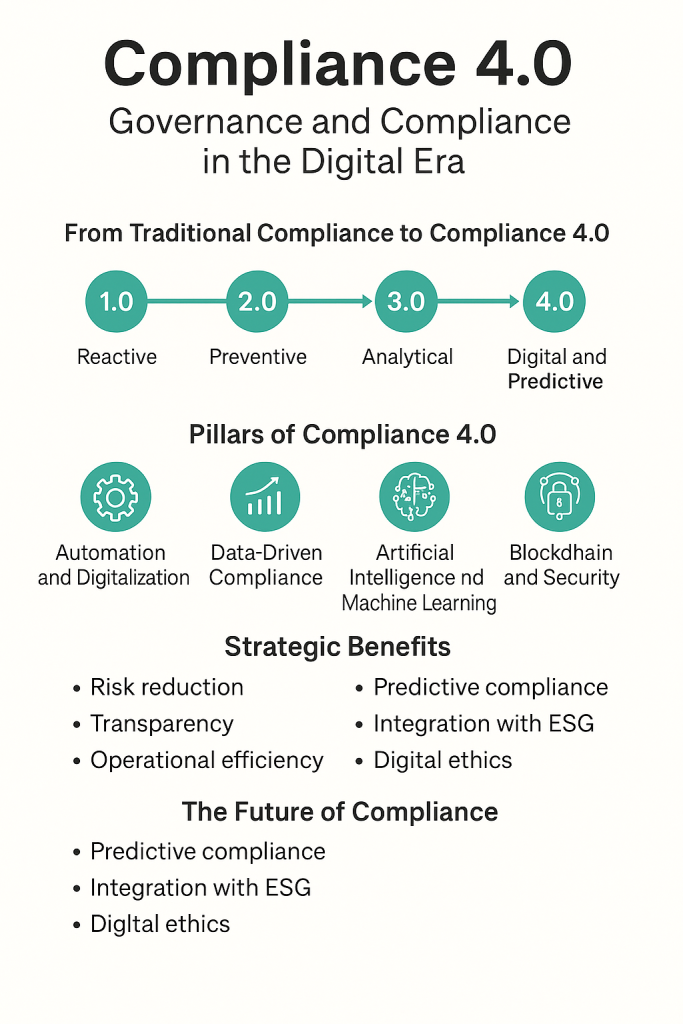Introduction
Compliance is no longer just a reactive and bureaucratic function. In today’s corporate landscape — marked by technological transformation, complex regulations, and greater stakeholder scrutiny — it has become a strategic differentiator. The concept of Compliance 4.0 represents this new phase, where artificial intelligence, big data, automation, and organizational culture come together to transform compliance into a continuous, predictive process integrated with business strategy.
From Traditional Compliance to Compliance 4.0
The evolution of compliance can be divided into four phases:
1.0 — Reactive: Post-event actions, manual controls, and a focus on punishment.
2.0 — Preventive: Introduction of policies and training to prevent risks.
3.0 — Analytical: Use of data to map risks and integrate business areas.
4.0 — Digital and Predictive: Application of emerging technologies to monitor, detect, and prevent risks in real time.
Today, the leap to 4.0 is inevitable for companies that wish to remain competitive and resilient.
Pillars of Compliance 4.0
Automation and Digitalization
Robotic Process Automation (RPA) can monitor transactions, review contracts, and cross-check regulatory data in seconds, freeing teams for strategic tasks.
Example: Banks using bots to check suspicious transactions and reduce false positives in anti-money laundering analyses.
Data-Driven Compliance
Dashboards and analytics make it possible to identify trends and predict risks before they materialize.
Example: Insurance companies using data analysis to detect patterns that indicate claim fraud.
Integration and Interoperability
Compliance systems connected to ERP, CRM, and regulatory platforms increase efficiency and reduce errors.
Artificial Intelligence and Machine Learning
Algorithms trained to identify anomalies help detect fraud, deviations, and atypical behavior with greater precision.
Blockchain and Security
Tamper-proof records bring transparency and traceability to contracts, supply chains, and audits.
Culture and Engagement
Compliance 4.0 only works when technology is supported by a culture of integrity. Gamified training and interactive content boost engagement and adherence.
Below is a visual summary of the evolution of compliance and the key elements that define the 4.0 approach:

Strategic Benefits
- Reduction of legal, financial, and reputational risks.
- Operational efficiency with lower compliance costs.
- Transparency in relationships with investors, clients, and regulators.
- Competitive advantage, especially in highly regulated markets.
Companies that invest in Compliance 4.0 find it easier to raise funds, close deals with major players, and maintain market trust.
Implementation Challenges
- Cultural resistance to change.
- Initial costs of technology and integration.
- Need for professionals who combine legal and digital expertise.
- Constant adaptation to regulations that evolve as quickly as technology itself.
Path to Adoption
- Assess the organization’s compliance maturity.
- Map priority risks and critical processes.
- Choose technologies aligned with business needs.
- Engage leadership and form multidisciplinary teams.
- Implement in phases, with continuous monitoring and improvement.
The Future of Compliance
The next trend is predictive compliance, supported by generative AI capable of interpreting regulations, suggesting policies, and auditing processes in real time. In addition, we will see:
- Integration with ESG, making environmental and social reporting part of the compliance scope.
- Regulators adopting 4.0 technologies to monitor companies.
- Greater focus on digital ethics, data protection, and the responsible use of AI.
Conclusion
Compliance 4.0 is not just a technological evolution — it is a mindset shift. It transforms compliance from an operational cost into a strategic asset, capable of strengthening reputation, driving efficiency, and opening new business opportunities. Organizations that embrace this approach not only meet legal requirements but position themselves as leaders in integrity and innovation.

